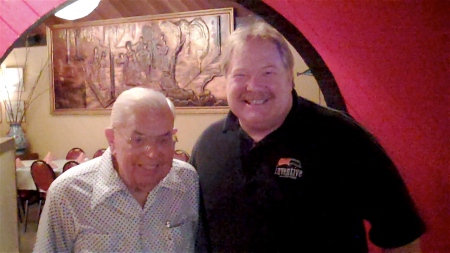It was a warm day in Southern California. The news had headlines about the terrible fires all across the hilltops of the Ranchos Palos Verdes area where I was headed and I didn’t know what to expect. Luckily the fires had been mostly put out and the actual fires were about two miles over the hill from where I was going. I was there to interview Roy Wolford, the official photographer for Northrop during those incredible test pilot years when Johnny Myers was risking his life on first flights. Roy had worked over 60 years for Northrop. Hard to believe these days that anyone could work one place for so long. Over the years Roy had worn many hats in many departments. He was the first photographer for Jack Northrop when he was pioneering the Black Widow and Flying Wing technologies. Eventually Roy led a whole department of photographers with high tech still and motion picture cameras. We talked for a long time about the different kinds of cameras and equipment he used to capture the test flights. Then we talked about John Myers. Roy was a good friend with John Myers since Myers first day with Northrop. Roy talked about the character, will, and integrity of John Myers. He talked about the leadership skills John had when he eventually became the VP of Northrop. Then we talked about the crash. Roy was there that day that John Myers had a terrible crash that nearly killed him. Roy told me about how he ran up to the wreckage and he screamed to John several times, only to see Myers totally quiet. Roy feared the worst but he kept screaming to John and finally he saw John’s eye twitch some movement and Roy realized John was alive. This was a very emotional moment of the interview. Roy is a great guy. He talked about how he first learned to fly and how much he loved aviation. Roy showed me several books on Northrop history and a lot of the photos from the test pilot days. In one book he showed me tons of photos of John Myers and the test pilots. All the photos had a credit to Roy Wolford. In one photo it showed several of the pilots all together with Roy in his flight suit. Roy flew in the planes being tested and outside the planes and in front of the planes and behind the planes. Roy’s photos were a tremendous help to the engineers working to test these aircraft. In the early days, the test pilots would have a small notebooks taped to their legs so they could make notes during a flight. Roy had the idea that photos would really help the engineers learn what really was happening during those flights. He was right. Thanks to Roy we have lots of photos of those early test flights and early planes. Roy has donated all of his photos and materials to several museums in the area. I am hoping to get access to them there and also through Northrop, who has kindly donated access to their archives for this project. Roy and I hit it off. I enjoyed talking to Roy very much. He lived during some of the most fantastic times in Aviation history and he was right there. He talked about flying with John Myers in the P61 and about his meeting Howard Hughes. Roy’s wife of over 59 years died a few years ago and now Roy lives in a nice assisted living place. But I don’t think he’s ready for much assistance yet. We went out to lunch and Roy showed me where the Western Aviation Museum is located at Torrance. Roy talked about how at the age of 94 he still feels strong and wants to keep active. At his apartment he showed me boxes where he has over 30,000 slides. Through his work at Northrop he was able to travel all around the world, including time during the Vietnam War in Southeast Asia. All the time, in every continent of the world, Roy Wolford took photos. I kept asking him how he could hand hold a camera and get perfect focus on those test flights. He said he had a steady hand and good eyes. As a lover of photography myself, I was in awe of the incredible skills of Roy Wolford. Meeting him was a true joy.
Monday, August 31, 2009
Subscribe to:
Post Comments (Atom)





No comments:
Post a Comment